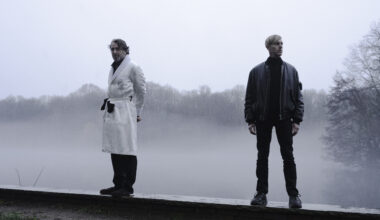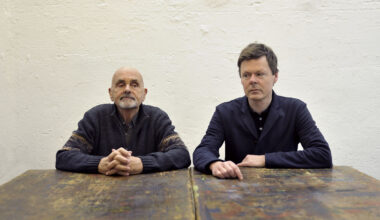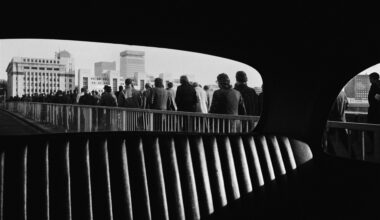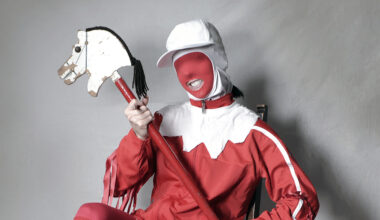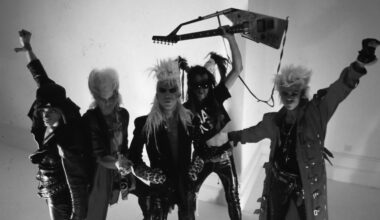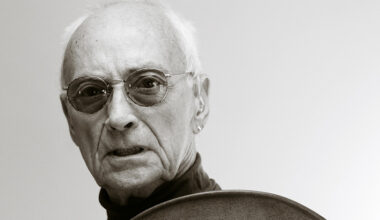With their back catalogue being lovingly reissued via Mute, we pile into a car for a guided tour of the Manchester hotspots that shaped the influential sound of A Certain Ratio… fasten your seatbelts
The last time I saw pioneering Manchester band A Certain Ratio, it was at the London nightclub, Heaven, in September 1981, when they were all whistles and baggy khaki shorts, shaved temples and stern faces. Back then, they were forbidding and their music was foreboding. They played a new kind of white boy dance music – funk noir, avant-funk, punk funk, as it was variously called – that has since been hailed as an influence on everyone from Franz Ferdinand to LCD Soundsystem, Happy Mondays to The Rapture.
Fast-forward 36 years and ACR’s core members – Donald Johnson, Jez Kerr and Martin Moscrop – are squeezed into a car, laughing and joking while driving through their home city, treating Electronic Sound to a personal guided tour of the legendary clubs and studios that made them Britain’s foremost radical funk collective.
It is a peculiarly Mancunian tale: in the first five minutes of its telling, 10cc have insulted them, Ian Curtis has praised them, Martin Hannett has smashed a packet of biscuits and Tony Wilson gets mugged. Several hours and a lengthy beer stop later, we will have arrived at an understanding of what made ACR great. Sort of.
“‘James Brown on acid’ someone called us,” offers Johnson, our designated driver.
“‘Shakatak with claws’,” shouts Moscrop from the front passenger seat.
“‘A fire in a pet shop’,” offers Kerr of one particularly oblique attempt to capture their unruly essence.
Not to be outdone, we suggest they were the missing link between James Brown and James Chance, Parliament and the Pistols. Moscrop isn’t convinced. But he is sure of one thing.
“We wanted to be the best,” he says. “We thought everyone else was shit.”
They did share, with their punk forebears, a penchant to provoke and, like their Factory Records labelmates Joy Division, they had a name mired in controversy. It was alleged that ACR got their name from Hitler’s credo that anyone with a certain amount of Jewish blood would be deemed Jewish. Actually, it was lifted from the lyrics of Brian Eno’s ‘The True Wheel’, from 1974’s ‘Taking Tiger Mountain (By Strategy)’. They were unlikely crypto-fascists, what with one of them being black and their trailblazing mission to assimilate black music methods and mores, but it certainly added to the myth.
In the beginning, in early 1978, the 18-year-old lapsed soul boys Simon Topping and Peter Terrell handled guitar, bass, a noise generator, and tentative vocals between them. Then Jez Kerr joined on bass following a gig at Pips, the dingy basement venue on Fennel Street where, at their most confrontational, they were assailed during a show with ice cubes. After Kerr, they drafted in guitarist Martin Moscrop from rival unit, Alien Tint.
“We said, ‘That guy should be in our band’,” recalls Kerr, pinpointing the reasons, both musical and sartorial, that Moscrop was hired. “He was dressed exactly like we were: baggy suit, sweater, haircut…”
“…Plus,” adds Moscrop, “I had a decent amp.”
They soon became part of the fixtures and fittings alongside the likes of Joy Division, The Fall, Manicured Noise and Mick Hucknall’s Frantic Elevators, and acquired a manager, one Tony Wilson, who had ambitions for them to become the city’s own Velvet Underground. ACR’s ‘All Night Party’, backed with ‘The Thin Boys’ was the second-ever release on Factory, and it had all the requisite energy and intensity. All they lacked was rhythmic direction. Or as Kerr puts it, “We just made a racket, so we decided what we needed was a drummer.”
In May 1979, Donald Johnson arrived, bringing a new musical and fashion sense to the band. There’s a famous image featuring Moscrop, Kerr, Topping and Terrell in matching demob suits and Salvation Army surplus, with Johnson the odd-man-out in cap, shorts… and tights.
“I was cold,” he says in his defense. “I needed some 10-denier, so I borrowed my sister’s brown tights.”

Our first stop is Strawberry Studios, the Stockport recording studio owned by 10cc, where Martin Hannett produced Joy Division’s ‘Unknown Pleasures’. Kerr remembers the Manc brainiacs “sitting in the foyer, laughing at our gear”. Strawberry was also where Hannett converted ACR’s 1980 ‘Flight’/‘Blown Away’ 12-inch into a masterpiece of percussive drama and rhythmic subterfuge. Kerr and Moscrop still recall the stark difference between the band before and after Johnson, between their 1979 ‘All Night Party’ debut and the deathly disco of ‘Do The Du’.
“When it was the four of us, we were influenced by The Velvet Underground, Brian Eno, Kraftwerk and Throbbing Gristle,” notes Moscrop as we head back towards Manchester. “Then, when Don joined us, we still had that style, but with funky drumming. That’s what made us unique.”
“Without Donald we were quite industrial,” says Kerr, rolling a cigarette as neatly as he can given the bumpy ride. “With his drums, we became even more manic and loud, but with extra power.”
We drive past TJ Davidson’s on Little Peter Street, the bleak rehearsal space they shared with Joy Division, where the latter filmed the video for ‘Love Will Tear Us Apart’.
“They were big fans of ours,” says Kerr, proudly.
“There was an interview with Ian Curtis where someone asks him who his favourite bands are, and he says, ‘A Certain Ratio’,” adds Moscrop.
ACR regularly supported Joy Division, and reluctant frontman Topping, whose natural singing voice was uncannily similar to Curtis’, even stood in for the troubled singer during a particularly riotous gig in Bury. Do they believe Curtis and co might’ve joined them in pursuing a more danceable solution had he lived?
“Nah,” says Moscrop, as tersely as their curt early funk. “They had their own thing. We did too.”
Did they ever discuss what they did, combining punk and funk?
“We never had conversations,” insists Johnson, who acknowledges the spacious/spacey-ness that he brought to the party, while Moscrop and Kerr detail the various effects (reverb, echo, delay pedal, bass chorus, wah wah, fuzzbox) that they used. They even had Hewan Clarke, later to become the Haçienda’s first DJ, joining them for gigs instead of the usual support band. ACR employed dub sonics and disco techniques, although they defer to Bristol’s The Pop Group when the conversation turns to who was first in the great space race to invent punk-funk.
“We used to go and watch The Pop Group,” admits Moscrop.
“They were shit-hot,” agrees Kerr.
We drive past The Reno (the long-gone black club in Moss Side where they would regularly play) and the Epping Walk Bridge in Hulme (scene of Kevin Cummin’s iconic “snow photos” of Joy Division) where ACR lived. Paul Morley went to meet them there for an NME cover story in September 1980, describing their fourth-floor dwelling as a “grubby human hutch”. It’s all spruced-up with affordable social housing now, but back then Hulme was Manchester’s Harlem, a no-go expanse of grim tenements where, as Kerr recalls with a shudder, flats were made using asbestos and “the buildings were so shoddy the wind would blow through gaps in the walls”.
Kerr points out the site of The Russell Club in Royce Road, Hulme, where, pre-Haçienda, Factory had a Friday night residency and where ACR, when they still had day jobs, supported Public Image Ltd.
“I got home from work and my mum said, ‘Tony [Wilson] has been on the phone and he wants you to get down to The Russell Club now!’,” he recalls, laughing. “I got straight on the bus with my guitar amp.”
Kerr has similarly vivid memories of the night.
“When I approached Jah Wobble’s bass amp,” he says, “which I was going to borrow, I noticed there was a handkerchief covered in shit hanging over the controls so I couldn’t change them. He was a nice chap, though.”
They would bump into PiL a couple of years later at the famed Danceteria club in New York. They remember John Lydon “trying to buy drugs off the house dealer”. As for ACR, with the exception of Johnson who eschewed narcotics, their tipple of choice was either hash or weed, mushrooms or acid, or any permutation of the four.
“We used to hammer hash and weed,” offers Kerr. “We’d have listening sessions in Hulme where we’d take acid just to listen to tunes, or take mushrooms… it was a very creative influence on us.”
The Graveyard And The Ballroom’, their December 1979 debut album (actually a cassette-only release), featured a studio side and a live side, capturing ACR at their grainiest and most darkly funky, notwithstanding the trumpets. And yet even with harrowing songs such as ‘Crippled Child’, they were offering signposts to music’s future. They indicate, on our left, Manchester’s Free Trade Hall, now a swish hotel, but back in the day it was where they supported Talking Heads, and David Byrne is alleged to have stood at the side of the stage, taking notes during the set.
For 1981’s, ‘To Each…’, they decamped to East Orange studio in New Jersey. It was a sojourn beset with problems. They were stopped at customs because the airport authorities believed they were a religious cult. Then Hannett’s recordings were wiped, causing the mercurial producer to “smash a few biscuits”, which may or may not be a euphemism. To top it off, Tony Wilson, carrying 10 grand from a deceased relative in a series of “manbags” got mugged at gunpoint on his way to buy a load of new percussion, so keen were they to pursue a Brazilian/Latin direction. Even that didn’t stop them, though, and on ‘To Each…’ you can hear ACR, through Hannett’s trademark murk, striving for the bold new sound they had in mind.
They finally achieved it on 1982’s, ‘Sextet’, recorded at Revolution in Cheadle with ACR themselves at the controls, and American Martha Tilson on vocals contributing to the brighter, breezier sound; a “twisted take” on the US and Japanese jazz-funk they were then listening to. Topping still sounded like Ian Curtis’ maudlin kid brother mind you, but there was a jazzy freshness to the music, even if it remained unquestionably sui generis.
“‘Sextet’ is where we realised all the things you could do in a studio with guitar, bass and drums,” observes Moscrop. “We were using harmonisers and nicking ideas off Martin Hannett to make it sound strange and otherworldly.”

By ‘Sextet’, and its follow-up, ‘I’d Like To See You Again’, which was also released in 1982, it seemed as though many of ACR’s ideas had been incorporated into the mainstream. There were Spandau Ballet, Heaven 17, Haircut 100 and ABC all having proper pop hits with ACR’s white-funk experiments. Were they annoyed?
“At the time, but not in hindsight,” says Kerr, who acknowledges the polished funk excellence and craftsmanship that went into songs such as Spandau’s, ‘Chant No. 1’ and ‘Gold’.
“We’d have loved a hit record, but we didn’t write that type of music,” adds Moscrop. Not that they didn’t mix in those circles. In New York in 1982, they were supported at one particular gig by none other than a pre-fame Madonna. It didn’t go too well: ACR’s roadies, “from Wythenshawe,” specifies Kerr, told her to “shut up, you plank” after she asked them to move their gear off the stage.
“I had the biggest stand-up, face-to-face row with her,” laughs Johnson, who refused to shift his drum kit. He did, however, acquire a new respect for La Ciccone, who had the brass cojones to stand her ground in the face of Manchester’s heaviest.
“I thought it was a brilliant thing she did,” he concludes.
We turn into Whitworth Street West, one-time home of FAC 51, aka The Haçienda.
“We used to live in there,” sighs Moscrop, somewhat ironically as today the building houses luxury apartments. “We had honorary membership, because we were on Factory. It was our local; we’d walk there from Hulme. We’d play there every few months. During the acid house explosion it was the big, euphoric place to go… until the cocaine and guns started coming in.”
Moscrop (who would go on to produce Madchester bands such as Intastella and World Of Twist and was music supervisor on the film, ‘24 Hour Party People’), stepped in as sound engineer at the club when underrated Manc funk-pop troupe 52nd Street performed there.
Johnson, too, enjoyed a career as producer for the likes of 52nd Street, Paul Haig, Section 25, Marcel King and others. Kerr has also undertaken production work (for The Wendys among others) as well as work on commercials. He tells us that he earned more for a single Alliance & Leicester ad than he has in 40 years as a musician.
But they’ve always stuck with ACR, through good times and bad. It was at The Haçienda that the rousing ‘Mickey Way’, from 1986’s ‘Force’, became a pre-house anthem. That was the album where Kerr and Johnson shared vocal duties following the departure of Terrell and Topping, who struggled to escape Curtis’ shadow, even after the Joy Division frontman’s death.
“I was quite happy being the bass player with my back to the audience, but as Tony Wilson said, I looked the most fucked up, so I got the job,” muses Kerr, possibly thinking of Shaun Ryder, Bernard Sumner and Mark E Smith. “It’s a Manchester thing. You don’t have to be a singer to be the singer in the band.”
Talking of Shaun Ryder, we pass The Boardwalk venue on Little Peter Street where ACR and Happy Mondays would rehearse.
“Shaun admitted recently that they’d hear us through the walls,” says Johnson, so maybe ACR’s riffs inadvertently provided the basis for Mondays’ grooves. Then again, the Mondays offered a different kind of funk tension, far slower than ACR’s frenetic early discord.
In a way, by the time the Madchester bands came around (the Mondays, and the Stone Roses would regularly attend ACR gigs in the early days), the music scene had caught up. For the second time, ACR had allowed their progeny to overtake them.
‘Good Together’ (1989) and ‘acr:mcr’ (1990) saw them flirt with major league success, signing to A&M and having big bucks spent on their recordings, but despite some fine music and a team-up with Pet Shop Boys’ producer Julian Mendelsohn, they didn’t manage to make a commercial breakthrough. For ‘Up In Downsville’ (1992), they signed to Rob’s Records, owned by long-time fan and New Order’s manager, Rob Gretton, whose rationale was that “you’re not a proper label unless you’ve lost money on ACR”.
Get the print magazine bundled with limited edition, exclusive vinyl releases

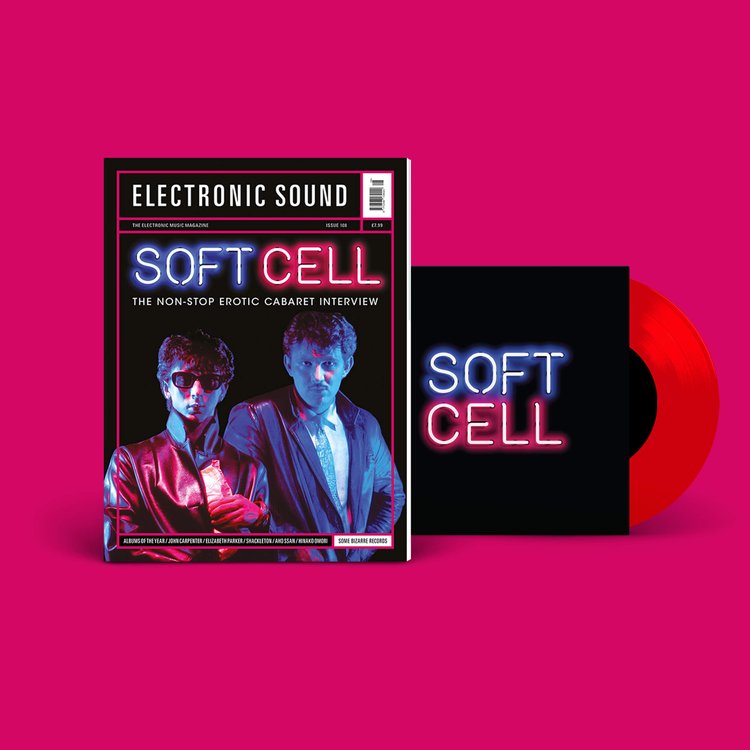

Today, Moscrop, Kerr and Johnson mix their day jobs with sporadic ACR activity: gigs, festival slots and recordings with artists old (Barry Adamson), and new (Australian band No Zu). Parked up and sat in the Favela bar in central Manchester, ahead of a signing session for the newly-reissued ACR albums, it’s a combination they particularly enjoy. Their back catalogue is being creatively exploited by Mute, which they describe as “like Factory, only without the chaos”.
“Daniel Miller wants us to be recognised,” explains Moscrop, who can be a bit withering. “We’re a band’s band, apparently. Unfortunately, there’s not enough bands out there to buy enough records to make us popular. We don’t want bands; we want punters! We can sell out gigs to 600 bald, fat, middle-aged guys, but they’re all going to die, aren’t they? And we’re going to carry on, so we need a new audience. We see Mute as a way of getting to them.”
“Factory’s idea was always to not let anybody know about us,” says Kerr of the label’s mastery of mystique and mythos. “That affected the way we are as a band. The main thing was never to get on Breakfast TV. The buzz for us was to play in a happening club, with a happening crowd.”
This year is their 40th anniversary, which could well see a new album, their first since 2008’s, ‘Mind Made Up’. Moscrop suggests calling it ‘40’, like Adele’s ‘19’, ‘21’ and ‘25’. Meanwhile, Mute will continue reissuing their back catalogue, and a “Best of…”, compiled in chronological order. What does the chronology tell us, we wonder?
“That we’re very old,” suggests Moscrop.
“That we never stand still,” offers Johnson, more reasonably. “That we’re always developing, moving ahead, trying to evolve.”
Were they more comfortable during the dark punk-funk era or the more sunny, upbeat Madchester era?
“We’re happier apart from it all,” ventures Kerr, relaxing into his second beer of the afternoon.
“And we’re still doing it,” says Johnson, heading off to the signing at the Magma bookshop to meet his public, including his two tiny grandchildren who have arrived wearing T-shirts emblazoned with the legend, “My Pops Is The Drummer”.
“We’re still,” he smiles, “doing the du.”
The reissues of ‘The Graveyard And The Ballroom’, ‘To Each…’ and ‘Force’ are out on Mute.

